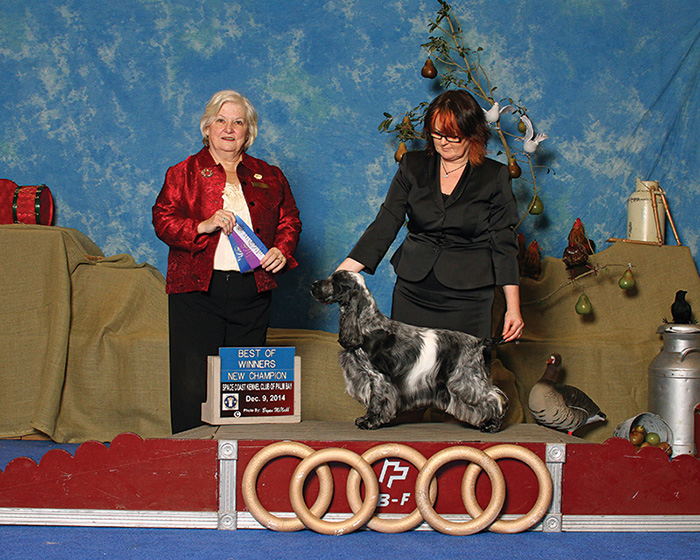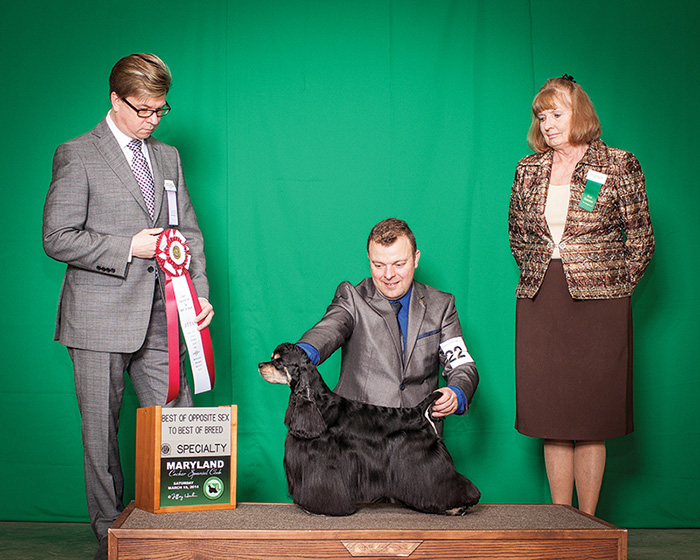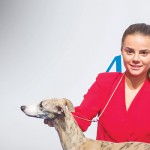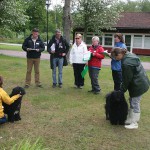Galaksi American Cockers & Cockergold English Cockers
Lotte & Michael Kristensen • Interview by Jovana Danilovic
Published in Annual 2016
BIS: First of all I would like to thank you for taking the time to do this interview. You have bred healthy and typey American Cocker Spaniels for generations now. How did you get started with American Cockers and why?
Lotte & Michael: We, Michael and Lotte Kristensen, are very happy to get the opportunity to present our breeding of American and English cocker spaniels. Our kennel is located in Dianalund, in the countryside at the western part of Zealand in Denmark. Our breeding of Galaksi American cocker spaniels go way back to the 1970s, when Michaels parents started the kennel, at the same time kennel Cockergold was founded by Lottes parents. Galaksi and Cockergold has now been passed over to the next generation and are now run in partnership since we got together 15 years ago.
Michael got involved in the dog-world very early in life and managed to be junior-handler of the year in Denmark two years and 2 year in Monaco, with final competitions at Crufts.
BIS: Which dog do you consider the foundation of your own breeding program?
Lotte & Michael: Both kennels have existed for more than 40 years, and has produced top-winning dogs of both breeds.In kennel Galaksi it is hard to point out one specific foundation bitch or dog, but it all started with CH Pepplestone Sound of Music. Another dog worth mentioning is CH J-R’s Rebel Strike, he came to Denmark in 2003 and has had a tremendous impact on the Galaksi American cockers producing very well-constructed off spring with excellent movement including CH Galaksi Million Dollar Baby.
For the last 10+ years the foundation bitch at kennel Cockergold has been CH Carillo Cover Design – she was a birthday present from Michael and is currently in most pedigrees named Cockergold. She was an amazing showdog and producer. She had 4 litters all with several champions.
BIS: What do you consider your greatest achievement in breeding?
Lotte & Michael: Both kennels have achieved the honor of being breeder of the year in Denmark all breeds. Most recently kennel Cockergold in 2010. Kennel Cockergold has also achieved stud-dog of the year with CH Carillo Cover Girl in 2007. It is very fulfilling as a breeder to win these titles confirming consistency and quality in the breeding program.
On the more personal level greatest achievements have been the breeding of particularly successful litters, the results obtained after hours of studying pedigrees, attending shows, looking at photos, spotting the right combination and then see the result in real life with high quality throughout a litter, with top-winning dogs.

BIS: What do you consider your greatest achievement in showing?
Lotte & Michael: Dog of the year all breeds in Denmark with CH Galaksi Million Dollar Question, and recently in 2015 Dog of the year 2 with CH Galaksi This is Me. Furthermore CH Galaksi Read all about it was dog of the year all breeds in Iceland.
We have had several World Winners over the years, WW 1992 Galaksi Sound of Nikita was even BIS 2 and WW 2014 PBJ Back in Black was BIS 4 shown by Michael. CH Cockergold Credit card took the title in 2010 and CH Cockergold All my Life achieved the WW title in 2015, in both cases with more than 200 entries in the breed. Kennel Galaksi had BIS breeding group and BIS stud-dog at the WW show in 1989, another great win. In the US CH Galaksi This is Me won the AKC Eukanuba National bred by Sporting group in 2013 and BIS owner handled in 2015. He is the only un-docked American cocker to ever win the Sproting group three times.
We have been awarded Cocker of the year in Denmark more than 10 times, American cocker more than 20 times and multiple Spaniels of the year and both kennels are consistently represented among the top-dogs in both breeds every year. Both kennels have been winning the group and had several BIS placements all over Europe at International and specialty shows.
BIS: How many dogs do you have at home (living with you) and how many you coown? How many litters approximately you have a year?
Lotte & Michael: In total we have approximately 25 dogs in the kennel living with us, half of them American, half of them English cocker spaniels. Approximately 10 dogs are co-owned living with other families, sometimes only for showing, sometimes we have co-owned bitches at the kennel for breeding. Co-ownership is always a delicate balance, a matter of mutual trust and clear agreements, but when it works it is an excellent way of expanding the breeding material available.
We have had the privilege of being trusted by other breeders to house and show some excellent dogs, these include American cockers like CH PBJ Back in Black from the US and CH Azels Always bet on the Black from Australia, and English cockers like CH Coastline Johnny be Good from Finland. To the owners we hope they have benefitted from the results these dogs have achieved, and to us it has been a possibility of adding valuable new genes to our current lines.
The number of litters during the last 10 years has varied from 1 to 6. Our rule of thumb is only to breed if we would like to keep a puppy from that specific combination – not saying that we always do, but it’s a way of securing internal quality control.
BIS: Please mention 2 or 3 American Cockers which are not owned, bred or shown by yourself, that you particularly admired, and tell us what you most admired about each.
American Cockers: Going way back worth mentioning are CH Tagalong’s Macho Man and CH Empire’s Brooklyn Dodger, both excellent specimens, well-constructed with excellent movement. Both were top-producers and would do extremely well in the show-ring today. Still going strong CH Casablanca Thrilling Seduction, is another dog of very high quality, and we have the pleasure of having these lines represented in CH Galaksi Smashing Seduction, being his half-sister.
English Cockers: One English cocker we would like to mention is CH Travis Vital Spark, he was a well-build dog with excellent movement, but most of all, he was an excellent producer, siring multiple champions all over Europe. He was very successfully bred to our CH Carillo Cover Design twice, producing 5 champions out of 6 puppies. Another cocker worth mentioning is CH Midnight Train vom Rauhen Holz, bred in Germany and living in Sweden where he was cocker of the year a number of years in row. He was moderate all over, but an excellent mover. Finally we would like to mention CH Lynwater Dawn Shimmer winning the Gundog group at Crufts back in 1994, she was representing the kind of English cocker spaniel we see today and was an excellent representative of the breed.
BIS: With how many kennels and who are the kennels you cobreed? How important was cooperation between breeders through the time?
American Cockers: We have had an excellent collaboration with the US kennel PBJ and Moody’s over the years;
English Cockers: We will be ever grateful to Kari Graanas kennel Carillo in Norway who gave us CH Carillo Cover Girl and another kennel worth mentioning is kennel Travis by Kari Haave. A number of Travis dogs are present in the lines of the Cockergold cockers and combining Cockergold and Travis lines have turned out very successful several times. That being said, we have no formalized collaboration with any kennel being in American or English cockers. We try diligently to identify what we find is the best combination and then we travel, if necessary overseas, no matter what kennel name the dog has as prefix, and only very seldom have we experienced to be rejected, though challenges have occurred, the dog world is competitive. We never compromise on quality and though we do have stud-dogs in both breeds, we tend to use stud-dogs from outside the kennel in more than 50% of our litters.
BIS: Did you have a mentor when you got started? And do you mentoring someone at the moment?
Lotte & Michael: As mentioned previously both kennels have been running in the family for decades, hence mentorship and parenthood has kind of been the same. Over the years we have had excellent discussions with breeders and judges all over the world, and you never get too old or too experienced to learn or at least consider the opinion of others. We have a passion for the junior-handling competition, and we have had the pleasure of supporting/mentoring a number of young talented handlers to success in this competition.

BIS: Tell us please the main characteristic you admire in the breed? What are your goals in the breeding program?
Lotte & Michael: The wonderful temperament characterizing American as well as English cocker spaniel is, and always has been, the driver in breeding these two wonderful breeds. The eager will to please, the ability to chill out in the living room and then in a second being ready to go for a walk, and have some fun. We are very much aware that both breeds are hunting dogs, and even though we do not go hunting ourselves, we have had the pleasure of experiencing skilled owners of Cockergold dogs using them in the field. This combined with a beautiful exterior and the characteristic sweet expression featuring both breeds makes it the obvious choice for us. Other breeds have been part of the Galaksi and Cockergold kennels including Standard poodle, Wirehaired foxterrier, Löwchen, English springer spaniel, and Lhasa apso, but our main breeds always have been American and English cockers. The overall goal in our breeding is to maintain these characteristics: the merry cocker, well-constructed with excellent movement and attitude.
BIS: In which ways breed has change over the time since you first got involved with the breed?
Lotte & Michael: An amazing thing with the American cocker is the fact that you can go back 30-40 years and find photos of dogs looking quite like top-winning individuals today. We are right now planning to use frozen semen from an American dog that died more than 20 years ago. In the English cocker spaniel much more has happened, the breed has improved in general construction with better and sounder angulation front and back, and much better movement. Coats have improved, and the grooming and way of showing has changed as well.
It should not be a goal in itself to change a breed over time, and the American cocker is the living proof, that if quality is high enough only minor adjustments are needed. In our opinion the English cocker spaniel has changed for the better and we hope to have contributed to this development.
BIS: How do you define “type”?
English Cocker: Talking about type in the English cocker is quite common, and what we hear most is classic type and Scandinavian type, where the classic type is defined as a more moderate type of cocker, short and very compact with very moderate feathering and the Scandinavian type is slightly longer with more angulation front and back. We actually think and try to take what is best from both worlds. We want a well-build dog and it has to be able to walk, to cover ground well with reach and drive, which is one of our hallmarks. Too us, some of the very classic typed dogs are beautiful when stacked but they simply can’t move, they are short stepped with no drive – the classic type also sometimes have too arching crops and low set tail, that we don’t favor. On the other hand being too long and low is the risk in exaggerating the Scandinavian type. We have used a few American bred English cockers, and we are impressed by the style and showmanship these dogs possess, but it is a balance. In general we find the American type English cocker, to be too straight in the front with very poor fore chests, hence we have only bred to selected individuals with a strong and consolidated front.
American Cocker: When it comes to the American Cocker, discussion about type is not that common. The origin country of the breed, the US, is by far the largest producer of the breed and kind of defines the type. We believe that we in Scandinavia have excellent representatives of the breed, but very few lines are purely Scandinavian and US dog are involved in most pedigrees. One thing though we have to mention, is the focus on topline – and you might consider that a type – a lot of breeders are so focused on the top-line that everything else gets lost, often you see very straight shoulders and poor fore chest and we am proud to say, that we believe we have demonstrated the ability to breed American cockers with excellent neck and well-angulated shoulders, we like to see the neck naturally fit into the shoulder and try to avoid a sharp angle separating neck and back.
In our opinion the discussion about type is not that interesting, you have to be true to the standard and to define what you like, and then don’t compromise. If one thing should be mentioned as most important to us, it must be movement. Breeding gun-dogs sound and healthy movement is essential.
BIS: Every breed has some common problems. Which is the most common problem in your variety seen from a breeder’s point of view?
Lotte & Michael: In both breeds x-raying for hip dysplasia has been common practice for many years in Scandinavia, but the cases are very rare and both breeds almost never show symptoms even if diagnosed.
In the English cocker spaniels the genetic screening for PRA and FN has turned out to be a very valuable tool reducing a previous challenge in this breed. A number of breeders are very keen on only breeding non-carriers, but with the genetic test it is perfectly okay to breed a carrier to a non-carrier. We have experienced that people have turned puppies down due to genetic status though quality was top, that we don’t really understand though it may be about understanding inheritance of the diseases. Sure we acknowledge that breeding non-carriers to non-carriers may be more convenient, but never compromise on quality. Currently, we only breed parti-color English cockers spaniels, we have had a number of solids, but though somewhat tabooed, we find that some challenges still remain in the temperament of the solid English cocker spaniels. Serious colleagues are working to improve this, but for now we stick to the parti-colored variant.
In American cockers we are eagerly awaiting the genetic test to determine cataract. This disease is a serious challenge in the breed, and breeders claiming never to have experienced this, have been very lucky, not bred that many dogs or are simply not telling the truth. We have had the frustrating experience of diagnosed juvenile cataract, and with the unknown hereditary nature of this disease it tends to strike without any clear pattern of lines, combinations or specific dogs. We hope to see a new test within a couple of years to guide the breeding and to the benefit of the breed.
BIS: In order, name few traits you look for in the ring.
Lotte & Michael: For both breeds we can say it quite short and simple: true to the standard, well-constructed all over and excellent movement topped with style and attitude.
BIS: What, if anything, do you feel non-breeder judges get wrong about the breed?
Lotte & Michael: In general we have to say, that judges all over the world, are doing a great job. Once in a while you run upon a judge, that being a breeder or a non-breeder judge, where you don’t agree. But that is actually okay, if you can see what the judge wants and the judging is consistent throughout the classes. Some judges are very focused on type, when compromising on quality, we don’t agree, but again, if consistent we do acknowledge the opinion of the judge.
Seldom have we experienced, and we guess that has been non-breeder judges, with an eye on one specific point in the standard i.e. the coat, but then you just have to say – comes another day comes another judge.
BIS: If you were in charge of everything regarding the dog shows what change would you make first?
Lotte & Michael: In Denmark and Scandinavia in general it should be the fee for shows. Shows are well arranged, running smooth and professionally – judges are competent and surely costs must be covered. But travelling both Europe and the US is costly in travel and accommodation, and limiting the number of entries due to high fees is a pity. We have experienced entrance fees of around 150 euro (160 US dollars) for World winner and other prestigious shows and as a consequence we have tried to limit number of dogs to enter. We believe that is a challenge not only to us but on a more general note.
BIS: What would be the most important single piece of advice you would give to all serious young breeders?
Lotte & Michael: When you want to start breeding carefully consider your starting material. Seek advice, identify approachable successful breeders (and most are, you just have to ask) for advice and information. Try not to be and act as a world champion breeder after only a couple of years, with the risk of sounding like a grumpy old man, history shows that being a successful breeder takes time and experience only can be obtained over time.



